Piazza Augusto Imperatore
Mausoleo di Augusto
The Mausoleum of Augustus was created by Augustus ca. 28 BCE, thus slightly before the Ara Pacis. After serving as the family mausoleum, it was altered over the centuries for different purposes. It served as a fortress and, as with many ancient structures, as a source of marble for later buildings, then as a hanging-garden, bull-ring, and in 1789 as an amphitheater. In 1907 it became Rome's symphony hall, the Augusteo, and was still in use as such at the time of the Fascist intervention in 1936.
Enough of its foundation and lower structure survives to establish its footprint and much of its lower level, and a number of documents indicate certain aspects of its design. However, much of its original form is speculative and various hypotheses (a few shown below) have been proposed. A study directed by John Pollini with collaborators, “Problematics of Making Ambiguity Explicit in Virtual Reconstructions: A Case Study of the Mausoleum of Augustus”, with outstanding illustrations, is available on the web.
The literatiure on the Mausoleum is of course extensive. The classic study of its transformatIon as part of the Fascist Piazzale Augusto Imperatore is Kostof's 1978 chapter with 58 informative photographs and diagrams. More recently, an outstanding article emphasizing the fascist reconstruction of the Mausoleum and Ara Pacis Augustae has been written by Artistotle Kallis, 2011 (see bibliography listings with annotations). The 3 drawings at the bottom of this thumbnail page (added to this website Oct. 15, 2012) show a 1956 proposal by Guglielmo Gatti for reconstructing the Mausoleum as a Museo Augusteo with the Ara Pacis relocated to a large, well-lit central hall.
TO ZOOM IN ON THE LARGE IMAGES, USE THE BUTTONS AT TOP-LEFT.
Tips for using this website

Two alternative proposals for the possible original appearance of the Mausoleum by Guglielmo Gatti, an outstanding scholar of both the Mausoleum and the Ara Pacis.
Scanned from Gatti, 1934, figs.6, 7. Reproduced with appreciation.
|
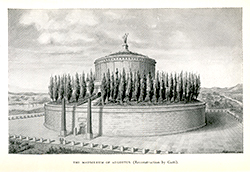
Reconstruction drawing by Guglielmo Gatti, an outstanding scholar of both the Mausoleum and the Ara Pacis.
Scanned from Robathan, 1950, pl.13. Reproduced with appreciation.
|
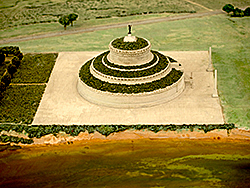
Model of Mausoleum of Augustus, part of a larger model of the norrthern Augustan Campus Martius, on display in the Musee dell'Ara Pacis. Gift of the Rotary Club Roma Sud. Model made by the Istituto Statale d'Arte Roma 2 (now Liceo Artistico Roma 2), directed by Prof. Antonio Celli.
photo July 2008
|
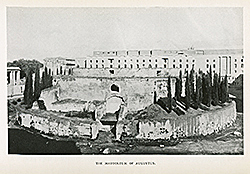
Ca. 1940s. Mausoleum from the south, showing the core of the structure that remained after the removal of centuries of addiitions. Cypress trees planted on the lowest of the circular tiers.
Scanned from Robathan, 1950, pl.12. Reproduced with appreciation.
|
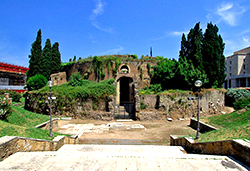
2005. Extreme wide-angle view of entrance of Mausoleum. At left the Museo dell'Ara Pacis under construction.
photo S. Sosnovskiy, 2005; reproduced with appreciation.
|
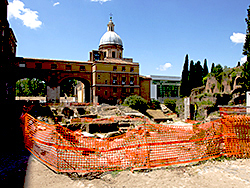
Beginning of major excavation of area in front of entrance to the Mausoleum, as part of the current restructuring of the piazza. Fascist addition to the back of San Rocco Augusteo at center; overpass to end of the Collegio degli Illirici at far left.
photo May 2010
s |
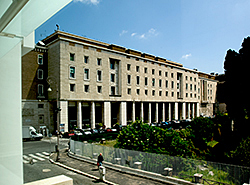
View from within the museum. Looking past the northwest corner of the Mausoleum at the right to the Istituto Nazionale office building B, constructed in 1938-40 as part of the new Piazzale Augusto Imperatore.
photo Oct. 2008 |
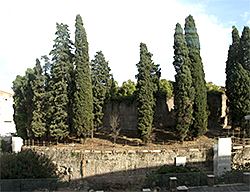
View from within the museum. Looking across the Via di Ripetta to the west side of the Mausoleum.
photo Oct. 2008
|
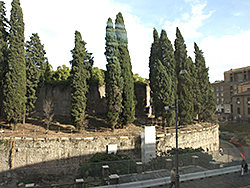
View of the mausoleum from within the museum. At the far right, along the south side of the mausoleum, is the Collegio degli Illirici, constructed 1938-1941 as part of the creation of the new Piazzale Augusto Imperatore.
photo Oct. 2008 |
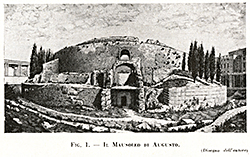
“Fig. 1. – The Mausoleum of Augustus.
(Drawing by the author)"
Scanned from Guglielmo Gatti, "Si Puo Valoizzare il Mausoleo di Augusto?", Amor di Roma. Roma: Arte della Stampa, 1956, p.174 Reproduced with appreciation.
|
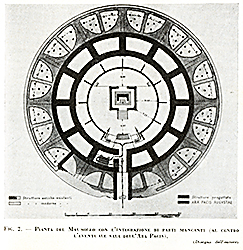
“Fig. 2. – Plan of the Mausoleum with the integration of missing parts (at the center the eventual hall of the Ara Pacis).
(Drawing by the author)"
Scanned from Guglielmo Gatti, "Si Puo Valoizzare il Mausoleo di Augusto?", Amor di Roma. Roma: Arte della Stampa, 1956, p.176. Reproduced with appreciation.
|
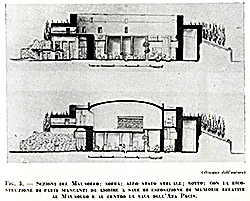
“Fig. 3. – Sections of the Mausoleum: above: in the current state; below: with the reconstruction of missing parts to be used as exhibition halls of memorials relating to the Mausoleum and at the center the hall of the Ara Pacis.
(Drawing by the author)"
Scanned from Guglielmo Gatti, "Si Puo Valoizzare il Mausoleo di Augusto?", Amor di Roma. Roma: Arte della Stampa, 1956, p.177. Reproduced with appreciation. |











